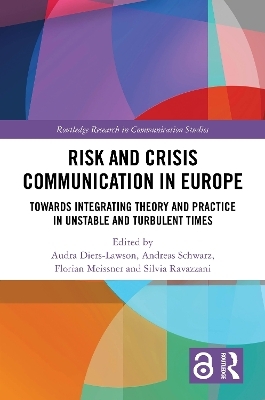
Risk and Crisis Communication in Europe
Routledge (Verlag)
978-1-032-43713-2 (ISBN)
Placing the rapidly developing field of risk and crisis communication within the context of a Europe in flux – experiencing the amplification of the refugee crisis, Brexit, increasing terrorist attacks, a heightened awareness of the climate crisis, and the COVID-19 pandemic – a cross-continental team of experts explore these developments from a theoretical and practical standpoint. Drawing connections between culture, digital technology, identity, public health, politics, and industry, the analysis offers a multitude of perspectives from across the continent and provides ways ahead for the field of risk and crisis communication.
This exciting and innovative volume will interest scholars and students of risk and crisis communication, media studies, political communication, public relations, political studies, and international relations.
Chapter 5 of this book is freely available as a downloadable Open Access PDF at http://www.taylorfrancis.com under a Creative Commons [Attribution-Non Commercial-No Derivatives (CC-BY-NC-ND)] 4.0 license
Audra Diers-Lawson is a Professor of Risk and Crisis Communication and Director of the PhD in Communication and Leadership at Kristiania University College. She wrote Crisis Communication: Managing Stakeholder Relationships and co-edited Pandemic Communication. She has collaborated with colleagues with the Asia Europe Foundation, WHO, and EU and currently serves as a member of the WHO Europe’s Technical Advisory Group for Risk Communication, Community Engagement, and Infodemic Management. Andreas Schwarz (PhD, TU Ilmenau, 2009) is senior researcher in risk and crisis communication at Technische Universität Ilmenau, Germany, is co-director of the International Research Group on Crisis Communication, and founding chair of the Crisis Communication Section of the European Communication Research and Education Association (ECREA), 2011–2018. Schwarz has received research grants to study risk communication of COVID-19, crisis communication of child protective services and nonprofit organizations, and perceptions of artificial intelligence or automated mobility. He is co-editor of the Handbook of International Crisis Communication Research. Florian Meissner is Professor for Media Management and Journalism at Macromedia University of Applied Sciences. He serves as Chair of the Crisis Communication Section of ECREA. His research focuses on crisis and risk communication in both journalistic and social media. As one of the Principal Investigators in the research consortium “DigiFit”, funded by the German Federal Government, he currently focuses on communication about digital security. He has practical work experience as a journalist for public broadcasters in Germany. Silvia Ravazzani, PhD, is Associate Professor in Management at the Department of Business, Law, Economics and Consumer Behaviour at Università IULM in Italy. Her main research interests include crisis communication, social media, and employee communication. Other research areas relate to diversity management and inclusion, sustainability, and related discursive practices.
Introduction
Part 1: An Evolving Field – Risk and Crisis Communication in Europe
Chapter 1: A Multi-Motive Risk Communication Model for “Making” Crisis Preparedness
Chapter 2: Marrying Crisis Preparation and Strategic Planning: Definitions and Challenges in Business Practice
Chapter 3: “Sharing is Preparing”: The Role of Information-Sharing in Collective Crisis Sensemaking During the July 22 Terror Attack in Oslo
Chapter 4: A Caring Framework for Crises and Disasters
Chapter 5: The Agents of Resilience: Generativity and Durability of Digital Platforms in Crisis-to-Crisis Transition
Chapter 6: Bridging theory and practice through crisis simulation: A framework designed to address the current development of risk assessment and crisis communication in Romania
Chapter 7: Coordination in Multi-Crises: The German Aviation Industry
Chapter 8: The Arcadia Crisis Postmortem: Lessons Learned for the Fashion Industry in Stakeholder Relationship Management and Value Co-Creation
Chapter 9: Managing a Legitimacy Crisis: Airline Sensemaking in the Context of Flight Shame
Part 2: Lessons Learned from COVID-19 for Risk and Crisis Communication in Europe
Chapter 10: Translating Research to Practice: Identifying Best Practice in Pandemic Communication
Chapter 11: Communication Inequality of Ethnic Groups in Public Health Crisis: State of the Art and Model of Community-Based Crisis Response
Chapter 12: How to do Evidence-Informed Risk Communication During an Emergency: Experiences from a Pandemic
Chapter 13: The Role of Culture in Risk and Crisis Communication Management: The Case of Switzerland and the Governmental Communication during the COVID-19 Pandemic
Chapter 14: The Finnish Government’s Strategic Ambiguity in COVID-19 Pandemic Communication: A Case Study
Chapter 15: The COVID-19 Pandemic in the Polish and British Media: A Content Analysis
Chapter 16: Information Seeking Repertoires in Migrant-Dense Swedish Suburbs During the COVID-19 Pandemic
Chapter 17: Understanding What is at Stake: Challenges and Opportunities for Corporate Communication during the COVID-19 Crisis
Chapter 18: Internal Crisis Communication and the COVID-19 Pandemic: Heading Towards a New Future?
Chapter 19: COVID-19 Communication in Portugal: Exploring the Relationships Between Sources of Information and Citizens’ Trust in Governmental Risk and Crisis Communication
| Erscheinungsdatum | 10.07.2024 |
|---|---|
| Reihe/Serie | Routledge Research in Communication Studies |
| Zusatzinfo | 22 Tables, black and white; 8 Line drawings, black and white; 21 Halftones, black and white; 29 Illustrations, black and white |
| Verlagsort | London |
| Sprache | englisch |
| Maße | 152 x 229 mm |
| Gewicht | 830 g |
| Themenwelt | Kunst / Musik / Theater |
| Informatik ► Grafik / Design ► Film- / Video-Bearbeitung | |
| Sozialwissenschaften ► Kommunikation / Medien ► Kommunikationswissenschaft | |
| Sozialwissenschaften ► Kommunikation / Medien ► Medienwissenschaft | |
| Wirtschaft ► Betriebswirtschaft / Management ► Marketing / Vertrieb | |
| ISBN-10 | 1-032-43713-8 / 1032437138 |
| ISBN-13 | 978-1-032-43713-2 / 9781032437132 |
| Zustand | Neuware |
| Informationen gemäß Produktsicherheitsverordnung (GPSR) | |
| Haben Sie eine Frage zum Produkt? |
aus dem Bereich


